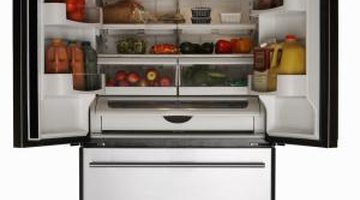How to Increase Water Pressure to the Refrigerator
Refrigerators with built-in water dispensers and ice makers rely on steady amounts of water pressure to work properly. Refrigerator water lines measure only about 1/4 inch in diameter so they're susceptible to kinks, which greatly reduce the water pressure. A small valve that controls the flow of water to the appliance also must be fully open in order to take advantage of the full water pressure available. This task requires moving the refrigerator so you may need a helper.

Step 1
Grab the refrigerator on both sides about halfway up the unit. Pull it away from the wall. You may need a helper to pull on one side while you pull on the other. Give yourself enough room to work behind the appliance.
Step 2
Locate the water line behind the refrigerator. Water lines are made of copper or braided plastic and usually sit at the bottom of the refrigerator.
Step 3
Follow the line with your hand from the refrigerator connection point all the way to the wall where it connects to a supply valve. Straighten out any kinks in the line, as they greatly decrease water pressure to the dispenser and ice maker.
Step 4
Turn the T-handle on top of the water valve in the wall counterclockwise as far as it will go. This will open up the line and allow all available water pressure to the refrigerator.
Step 5
Make sure the water line is not in a position where the refrigerator might crush it as you push the appliance back into place. Gently push the refrigerator back against the wall.
References
Tips
- Frozen water lines can reduce water pressure. Don't install water lines where they may come into contact with outdoor air.
Writer Bio
Heath Robert has been a professional writer since 2001. Covering news, politics and local communities, he has worked for daily newspapers across Colorado, including the "Columbine Courier" and the "Colorado Statesman." Robert holds Bachelor of Arts degrees in journalism and political science.
Photo Credits
- Ryan McVay/Photodisc/Getty Images
More Articles



